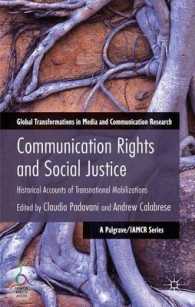- ホーム
- > 洋書
- > ドイツ書
- > Social Sciences, Jurisprudence & Economy
- > Politics, Society, Work
- > social science
Full Description
Globally, women are having half as many children as they had just fifty years ago. Why have birth rates fallen, and how will low fertility affect our shared future?
In Decline and Prosper!, demographic expert Vegard Skirbekk offers readers an accessible, comprehensive and evidence-based overview of human reproduction. Readers learn about the evolution of childbearing across different populations and how fertility is related to (changes in) our reproductive capacity, contraception, education, religion, partnering, policies, economics, assisted reproduction, and catastrophes. Readers will explore the future of family size and its impact on human welfare, women's empowerment and the environment. Skirbekk argues that low fertility is on the whole a good thing, while recognizing the challenges of population aging and "coincidental" childlessness. A balanced, integrative examination of one of the most important issues of our time, Decline and Prosper! drives home the fact that we must ultimately adapt to a world with fewer children.
The book will be invaluable to anyone who is interested in the far-reaching effects of global fertility, including researchers and students of demography, social statistics, medical sociologists, family and childhood studies, human geographers, sociology of culture, social and public policy.
Contents
Introduction.- Measuring Fertility.- How Many Children Can Humans Have Biologically?.- Fertility from the Dawn of Humanity through the 19th Century.- The Demographic Transition: Fewer Deaths and Fewer Births, Eventually.-Contemporary Global Fertility.The New Have-Nots: Childlessness in the 21st Century.- More Education, Fewer Children.- An Era of Choice: Childbearing Has Become More Planned.- Fertility Preferences: How Many Children Do People Want?.- Delaying Parenthood, For Better and For Worse.- Finding a Mate: Contemporary Partnership and Conception.- Money Matters: The Economics of Fertility.- Fertility in the Aftermath of Disaster.- New Times, Old Beliefs: Religion and Contemporary Fertility.- Contemporary Fertility from an Evolutionary Perspective: Are the Fittest Still Surviving?.- How Low Will It Go? Projecting Future Fertility.- Fertility, Population Growth and Population Composition.- FertilityPolicies: Past, Present, and Future Directions.- Low - But Not Too Low - Fertility is a Good Thing.








